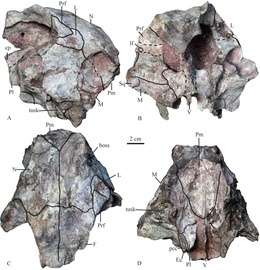Tetrapod fossils from the Late Permian of Shanxi Province, China.
[sciencythoughts.blogspot.com]
Chinese Permian Tetrapods have been known for decades. Dicynodon sinkianensis, now revised as Jimusaria sinkianensis, from the Guodikeng Formation of Xinjiang was the first to be reported 1934. Later, Dicynodonts were reported from the Quanzijie Formation and Wutonggou Formation of Xinjiang as well. In North Qilian area, a Dicynodont species, Dicynodon sunanensis, was described from the Sunan Formation and revised as Turfanodon bogdaensis or Turfanodon sunanensis subsequently. However, no Pareiasaur fossils have been reported from Xinjiang. In Inner Mongolia, many Tetrapod specimens have been discovered and at least four Dicynodont species and one Pareiasaur species are present in Daqingshan County. In North China, the upper Permian Sunjiagou Formation and Shangshihezi (Upper Shihhotse) Formation have the widest exposure of all contemporaneous deposits, and their distributions are adjacent to the Daqingshan area. Many Pareiasaur species have been named for the specimens from the above formations, however, no Dicynodonts have been reported. The only known Tetrapod locality in the Shangshihezi Formation of Henan Province is dominated by the Pareiasaur Honania. In 2014, a tusked dicynodont snout was collected from the Sunjiagou Formation in Baode, Shanxi, which confirmed the presence of dicynodonts in this stratum. In 2013, a fossil hunter, Bai Zhi-Jun, discovered some bones from Shouyang and Yangquan, Shanxi Province. His initial work led to subsequent discovery of Pareiasaur and Dicynodont specimens from both the Sunjiagou Formation and Shangshihezi Formation.


Enjoy being online again!
Welcome to the community of good people who base their values on evidence and appreciate civil discourse - the social network you will enjoy.Create your free account
Recent Visitors 12
Notlost
Northeastern Oklahoma,
Fernapple
UK
Hathacat
IL, USA
EyesThatSmile
Gulf Coast Of Texas,
Surfpirate
Canada
Photos 292 More
Posted by JoeBKite-like structures in the western Sahara Desert.
Posted by TriphidAn Aussie Indigenous Message Stick.
Posted by TriphidIndigenous Australian Aboriginal Rock art dated somewhere between 20 and 30 thousand years old.
Posted by TriphidIndigenous Australian Aboriginal Rock art dated somewhere between 20 and 30 thousand years old.
Posted by TriphidIndigenous Australian Aboriginal Rock art dated somewhere between 20 and 30 thousand years old.
Posted by TriphidIndigenous Australian Aboriginal Rock art dated somewhere between 20 and 30 thousand years old.
Posted by JoeBDortoka vremiri: A new species of Dortokid Turtle from the Late Cretaceous of the Hațeg Basin, Romania.
Posted by JoeBThe Cabeço da Amoreira burial: An Early Modern Era West African buried in a Mesolithic shell midden in Portugal.
Posted by JoeBMusivavis amabilis: A new species of Enantiornithine Bird from the Early Cretaceous Jehol Biota of northeastern China.
Posted by JoeBTorosaurus in Canada.
Posted by JoeBStone tools from the Borselan Rock Shelter, in the Binalud Mountains of northeastern Iran.
Posted by JoeBDating the Lantian Biota.
Posted by JoeBBashanosaurus primitivus: A new species of Stegosaur from the Middle Jurassic of Chongqing Municipality, China.
Posted by JoeBDetermining the time of year when the Chicxulub Impactor fell.
Posted by JoeBSão Tomé and Príncipe: Possibly the last country on Earth never to have been visited by a working archaeologist.
Posted by JoeBMambawakale ruhuhu: A new species of Pseudosuchian Archosaur from the Middle Triassic Manda Beds of Tanzania.






